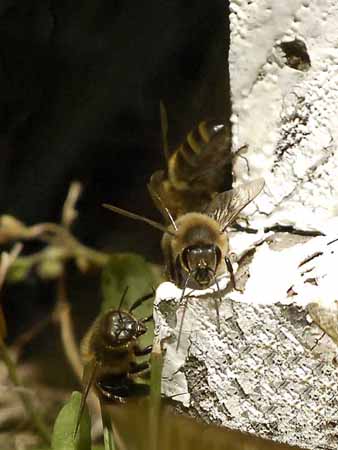
Text and pictures by Nicole Bouglouan
Many thanks to Stan, a passionate beekeeper who brought more details to this work.
Sources :
Biology Teaching and Learning Resources
Wikipedia, the free encyclopaedia
Western Honey-bee and Hornets
Asian Hornet and European Hornet: the predators
Apis mellifera, Vespa velutina and Vespa crabro
Western Honey-bee is native to Europe, Asia and Africa. Introduced to North America in the 1600s, this species is now widespread throughout the Americas.
Several races are recognized according to the range.
Bees are social insects living in huge colonies including one mother, the queen, and her offspring, meaning several thousands of individuals. The queen is larger than other bees with larger abdomen. She is able to lay 1500 to 2000 eggs per day.
A bee’s body is composed by head, thorax and abdomen. There are three pairs of legs and two pairs of wings on the thorax. The wings are linked at the base and move together in flight.

The workers collect the nectar from flowers by their long “tongue” or labium. This nectar is pumped and swallowed, and later, regurgitated at the hive.
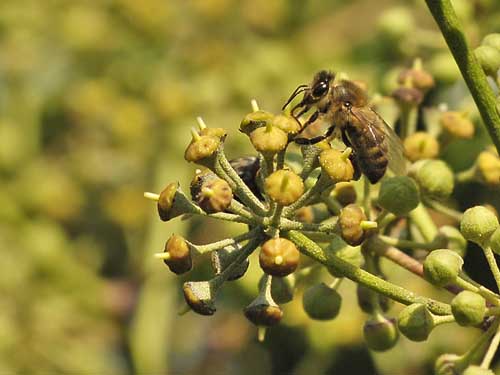
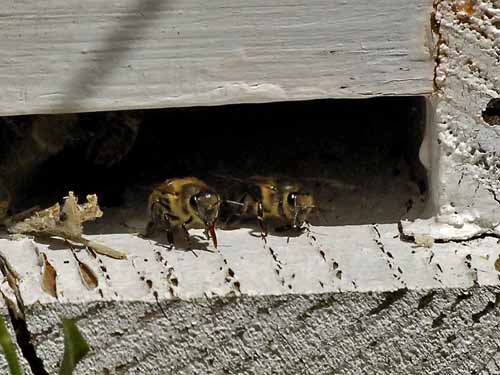
This is the beginning of honey-making… To make simpler, the workers swallow the nectar and mix it with enzymes, before to regurgitate it into the store cells. In order to produce the evaporation of water, the bees perform rapid wing movements to create a draft throughout the hive. When the honey is drier, they close the store cells where it remains.
Pollen and nectar are kept in the upper sections of the hive, from where it can be removed by the beekeeper.
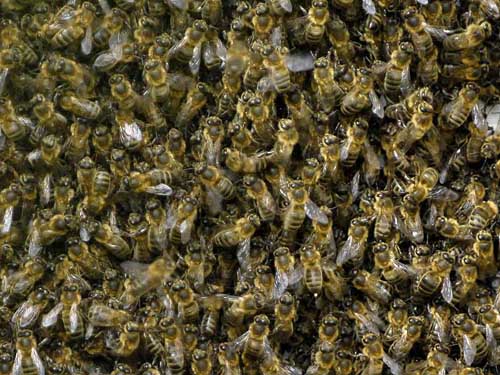
But to explain this wonderful and highly organized work here is not my aim. Numerous keen people have made it better than I could do.
I only wish to share with you an amazing experience with bees. We have been so lucky to be present during swarm’s formation in our backyard in the afternoon and to see the hard, long and quiet beekeeper’s work, in order to remove gently the swarm from the tree and to save the bees by providing them a hive.
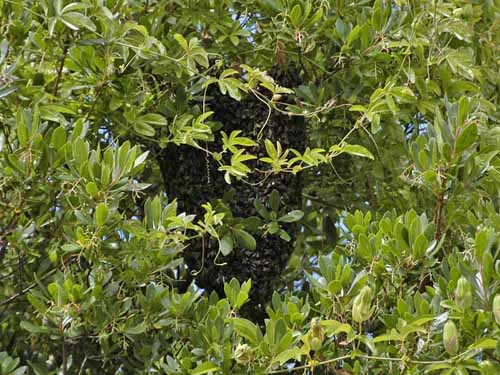
Bees are useful and invaluable for us. They play an important part in pollination, giving us flowers and fruits. For this reason, to save a swarm is the best thing to do. We must not destroy it.
This swarm contains the queen and thousands of workers. They leave the hive, often in spring or summer, and search for a resting place such as a hole in tree branch, a chimney or similar ones. Some days before, several bees seek a good location to make a new nest. When they have found the best situation, they return to the hive and communicate this information to the other bees. The whole swarm leaves the hive and moves off to the new place.
This is that happened some days ago in our garden.
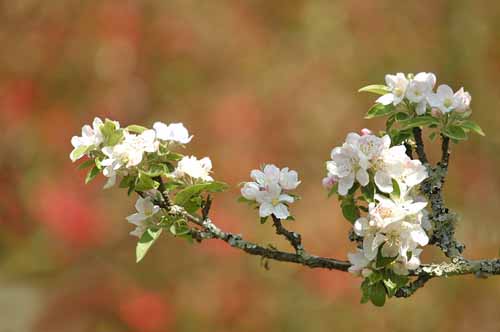
A persistent buzzing coming from the top of our Strawberry Tree (Arbutus unedo) encourages us to raise our eyes, and the surprise is big! A cloud of numerous bees is flying and buzzing above our heads. A swarm is probably forming in the tree. Looking at it from another side, we can see a large swarm with a height of about 40/45 cm, hanging from a branch and partially hidden in the vegetation. The bees are coming from the air and gather at this moving thing. What a beautiful structure!
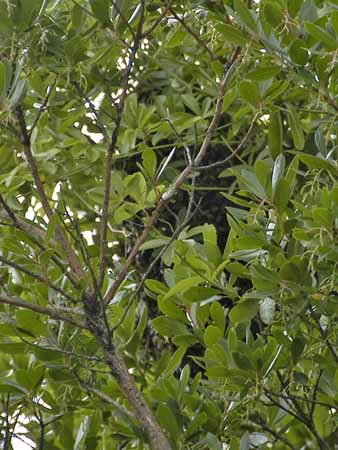
But the only thing to do is to get the help of a beekeeper. Bees are so threatened here in SW France by both Asian and European Hornets (mainly the Asian Hornet), we must save this swarm.
Fortunately, a young enthusiast beekeeper arrives very quickly, and after an attentive observation of the situation, starts to prepare his tools. The swarm is relatively big, with about 50/60 000 bees. First, a ladder! The swarm is about 5/6 metres up above the ground. Then, the complete protection-suit against the stings, absolutely essential because the bees may become very aggressive during such works. In addition, a cask with a fine netting to allow the sight, and thick gloves complete the safety dress.
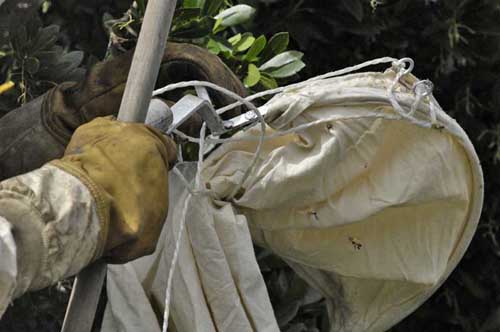
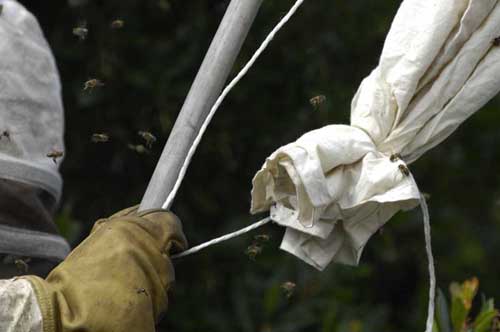
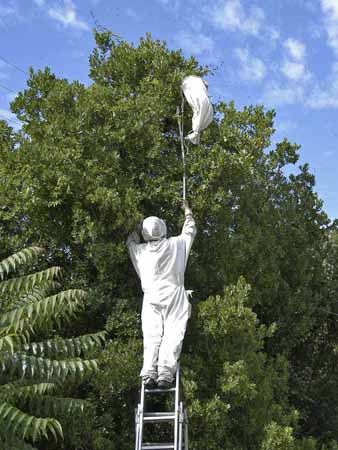
A hive is now at the base of the tree, expecting its occupants. And finally, the main tool which will allow to reach the swarm and to save the bees, step by step, the telescopic pole equipped with a long tubular sack. This sack can be closed at both sides. It is open at top for taking the bees while the base is closed with a string.
All tools and dress are white, except the roof of the hive. This is a deliberate choice: the white does not attract the bees…
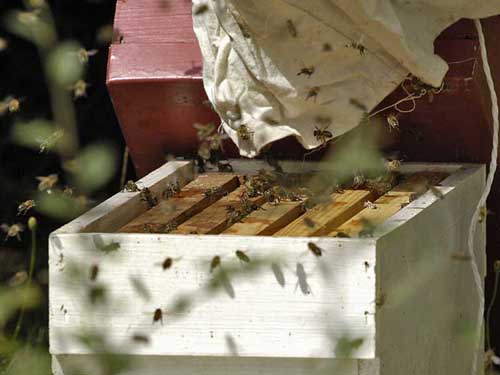
The different operations in the salvage of the bees can start. The beekeeper reaches the top of the ladder with the perch and the sack placed at the base of the swarm, and begins to shake the branch where the bees are stuck together. And a part of the swarm falls down into the sack.
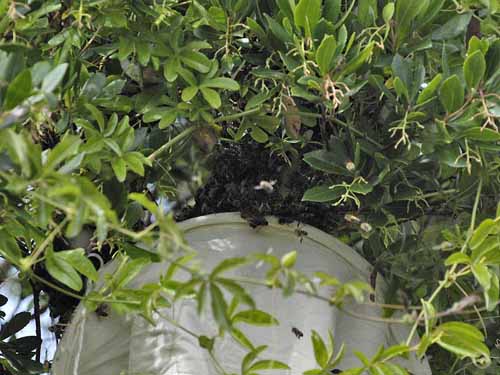
Then, the beekeeper moves the bees by shaking the sack above the hive.
The main goal is to “catch” the queen. If the queen is moved into the hive, all the bees will follow her little by little. But the first time is not good, as the second one! Finally, the third action allows to catch the queen, and the other bees appear to remain in the hive instead to rise again to the swarm. This work will be repeated several times, before almost all the swarm remains in or around the hive.
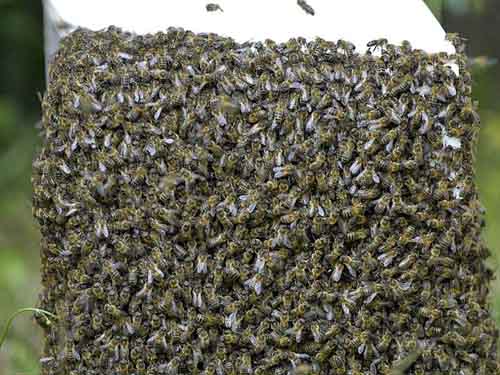
The quantity is impressive as the beekeeper leads the insects towards the entrance. He pushes them gently with his hands protected by the thick gloves. This is fascinating!
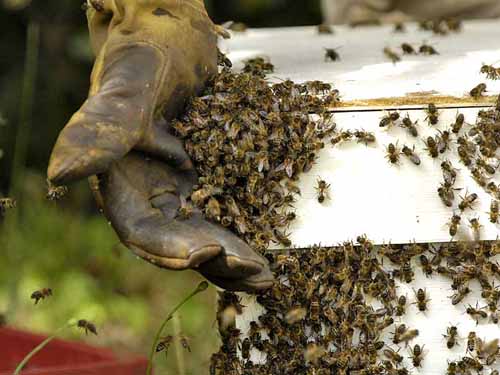
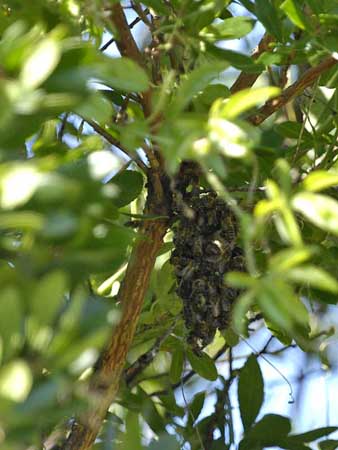
Several hours later, at sunset, the hive is very quiet, with only some bees at the entrance.
Will see tomorrow!
Unfortunately, several dangers threaten these active insects…
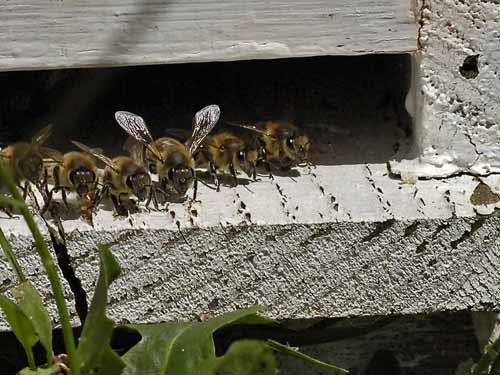
The following morning, after a quiet night, the hive is buzzing and busy! Bees are flying around in trees and among flowers. Any bee on the branch, all are now together in the hive.
They communicate by touch and smell, and are able to identify other members of their own colony, only by touching the antennae.
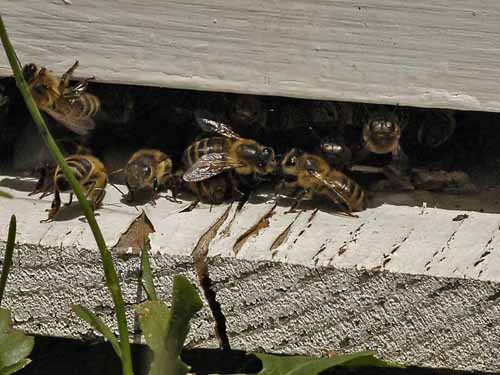
Vibrating wings is another way to communicate between them. They also dance, following an 8-shaped figure in order to indicate good food sources. Their social behaviour through many signals is impressive.
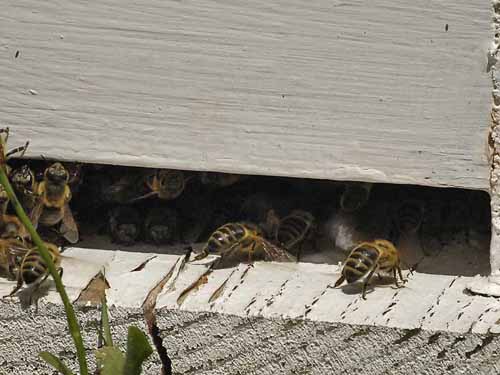
But the main threat is the Asian Hornet (Vespa velutina). This large hornet kills the bees at the hive entrance and carries its prey to eat some parts of its body.
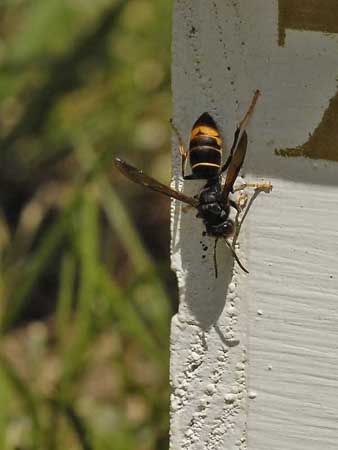
Currently, our bees do not know how to defend themselves. However, we have observed some threat displays with straight wings, raised antennae and fore legs towards the predator in aggressive posture.
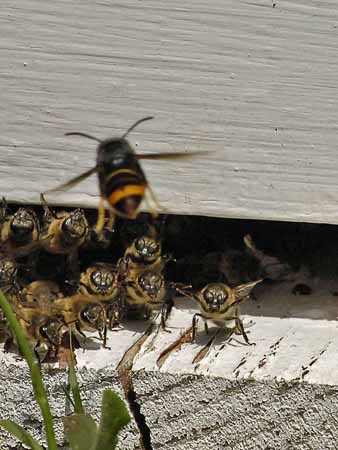
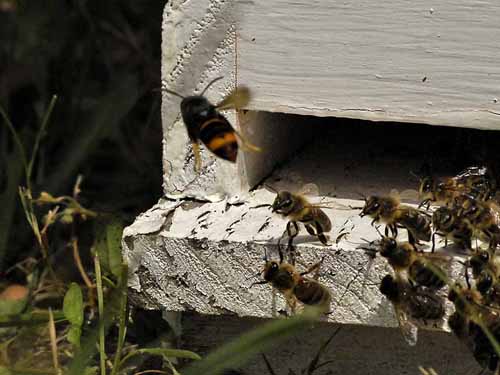
The bees also were gathered together, forming a compact mass in front of the hornet, as some small fish species do facing large predators.
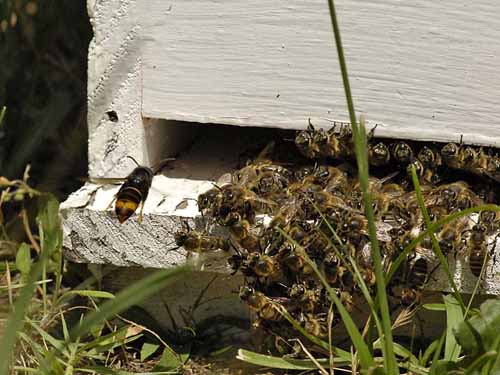
This one has come several times, taking sometimes one bee, but often going away empty-handed! Maybe the first attempts to defend themselves against this giant…
But unfortunately, the European Hornet (Vespa crabo), is a threat for the bees too, although less active than the Asian Hornet. It is large and heavy but clumsier.
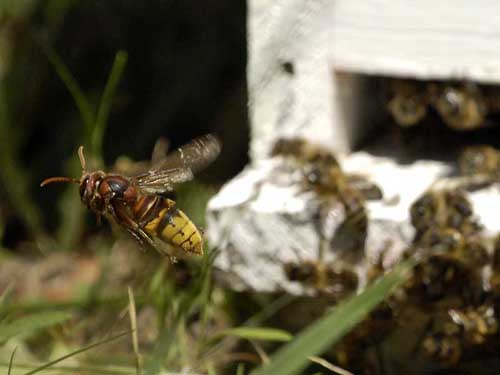
The bees use different manner to defend against this one, maybe less aggressive, with only some bees in threat posture.
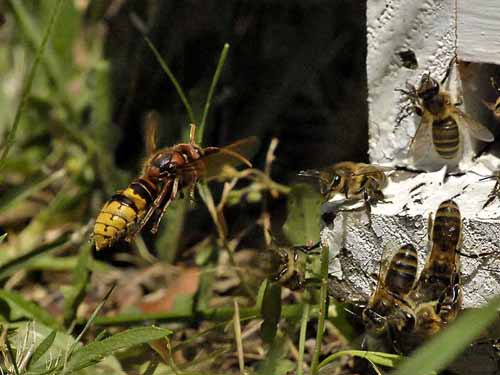
But it often takes some of them too, and eats them in the same way that the Asian Hornet.
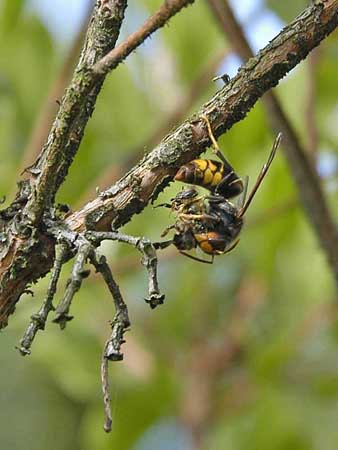
These observations give us hope they finally will learn how to defend themselves against these giant killers.
We cannot imagine nature without bees! Any flower or fruit, nothing… We must protect them by driving away the predators as often as possible, in order to enjoy a true nature with its colours, smells and buzzing insects!
When a bee is caught by a hornet, the predator carves her body and only takes the crop.
Once the whole hive is killed by hornets, they take the bee’s larvae to feed their offspring and partially consume the honey. Then, they attack another hive.
A single hornet’s nest is able to kill 4-5 colonies of bees. It may travel several tens of kilometres to find its preys.